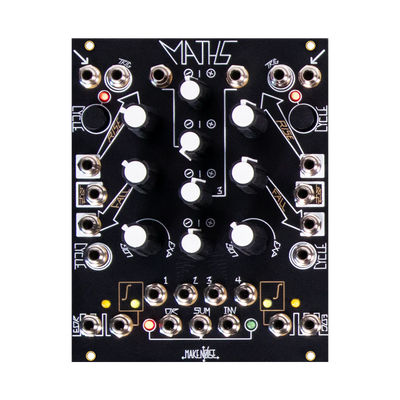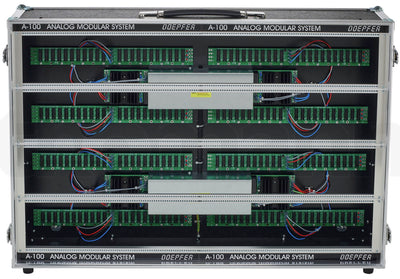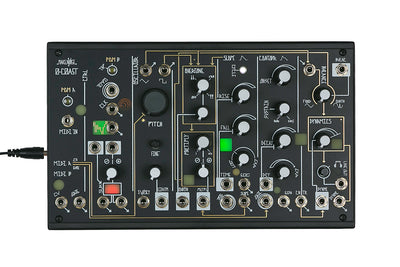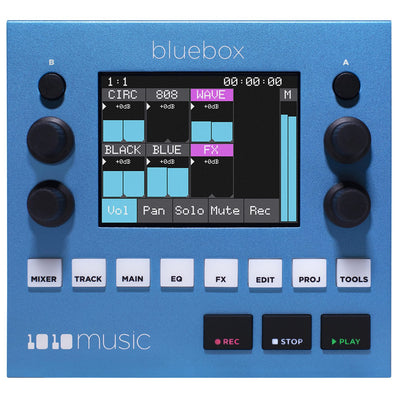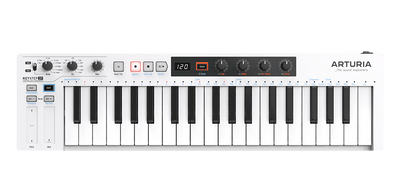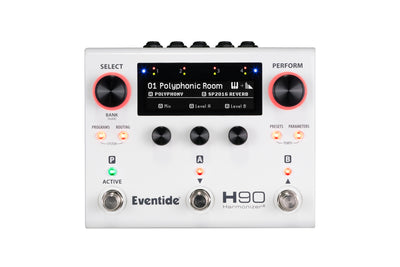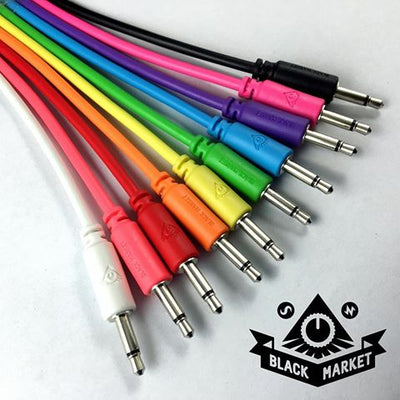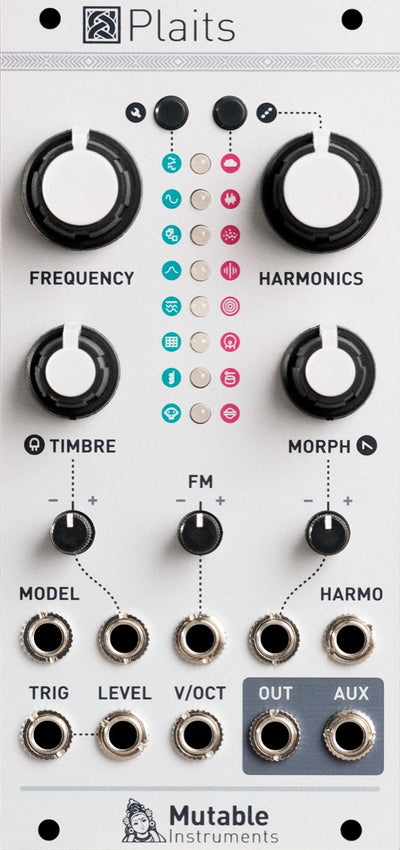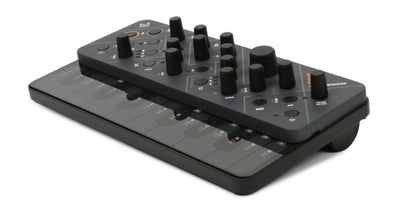A beautiful sounding and versatile next generation analogue phaser, with many added features which combine to take all pass phase shifting to a completely new level. The circuit design is based on the critically acclaimed vintage "Small Stone" phaser, expanded from 4 to 12 stages. We have fitted a unique multi tap switching system which allows stages to be individually selected for both the Output and Emphasis return path, allowing a huge variety of phasing sounds.
Features include two inputs with independent Level Controls, and a Phase “Colour” Control, along with a "Wet" output. We have included CV inputs for voltage control of both Phasing Depth and Emphasis (Resonance) levels, so that these can be fully controlled from other Eurorack modules or external voltage sources. It can be used in Mono IN, Mono Out mode or Mono IN, Stereo OUT modes, with the stereo outputs taken from the Stage and Emphasis paths.
In addition to a manual Frequency control it includes two separate Frequency CV inputs; FCV1 and FCV 2 with an attenuverter. An inbuilt, wide ranging LFO is normalised to FCV 1 input, and an LFO output jack allows the internal LFO to be used as a modulation source for other Eurorack modules.
Module Width: 18hp
Module Depth: 26mm (Including power lead)
Current Usage: 90mA Positive, 85mA Negative
In Depth
The Next Phase is the all new, fully analogue, next generation update of our earlier, and now discontinued, MegaPhase 12 phaser module.
New Next Phase features include independent Level Controls for Input 1 and Input 2, and a Phase “Colour” Control, which can subtly lighten or darken the phasing effect. We have completely redesigned the four layer circuit board for enhanced noise suppression, and have used even lower noise internal VCA’s and audio op-amps, so that the S/N ratio is improved and the noise floor is considerably reduced compared with the previous MegaPhase 12 phaser.
Like its predecessor the Next Phase is a Eurorack format voltage controlled phase shifter, which is based on the vintage "Small Stone" four stage Phaser circuit. It has been expanded from four to to twelve cascaded stages and includes multi tap switching capability, with independently selectable Stage and Emphasis stage selection, along with selectable feedback inversion and a phase Colour control. An onboard wide range Triangle wave LFO and two independent modulation inputs, along with CV control of Depth and Emphasis parameters, combine to offer an immense range of control over the phasing sound and character.
Huge range of phaser sounds
Usually a phaser only offers one type of phasing effect, which is determined by the topology of the phaser circuit used. Now the choice is yours, as the Next Phase can be switched to be either a 2, 4, 6, 7, 8, 10, 11 or 12 stage Phaser! However, the really interesting feature is that a different stage can be selected for the Emphasis (resonance) path, which can be selected from stages 4, 6, 7, 8, 9, 10, 11 or 12. As each of the individual all pass stages are inverting, then selecting an even stage for the output and an odd stage for the resonance (or vice versa) will cause invertion of the Emphasis feedback signal against the Stage signal, for a whole new set of phase cancellations. This very versatile switching arrangement, in conjunction with the Phase Colour control, allow many different types of phase cancellation to be explored, so rather than just having a single, "fixed" phaser sound a wide range of different sounds are now available. We have also modified the Emphasis circuit and improved its bandwidth so that much deeper, more extreme levels of resonance are possible giving an even wider range of sounds, and now in stereo too!.
The Smallstone phaser was famously used on synthesisers (rather than guitar) by Jean Michel Jarre on several of his early albums, and of course all of these sounds can be readily reproduced by the Next Phase, simply by switching the Stage and Emp-Stage switches to stage 4.
Built in LFO and external modulation possibilities
A wide ranging, triangle wave LFO is included, which has an amplitude of 10v p/p, along with a bi-colour LED which changes colour to indicate the positive or negative excursions of the LFO Waveform. The LFO has an external front panel output too, so that it can also be used as an external LFO with other Eurorack modules if desired, and of course the Next Phase can still be used simultaneously too.
The Frequency control knob allows manual control of Frequency, and the output of the LFO is normalised to the FCV 1 Input, so that LFO modulation can be applied to the phaser core frequency simply by turning the FCV 1/LFO knob clockwise. However, an external modulation source can be used instead of the internal LFO simply by patching it in to the FCV 1 jack so that it defeats the internal normalising.
There is also a second Frequency CV, input FCV 2, and its associated FCV 2 level control; however the FCV 2 control is an attenuverter rather than a regular level control. This means that in the centre (approx 12 o'clock) position, none of the modulation voltage patched to the FCV 2 input will affect the cut off frequency of the filter, however as the FCV 2 control is turned clockwise from centre then the voltage or waveform applied to the FCV 2 input will increasingly affect filter frequency. If the control is turned anti-clockwise from centre then an INVERTED voltage or waveform is applied to the filter cut off frequency. This is much more useful tha a regular level control, as it combines both level control and inverter in one convenient control. This invert function is also very useful if combining two Next Phase units for true stereo imaging, the output of the LFO on Next Phase 1 would be fed to the FCV 2 Input and the FCV 2 attenuverter control then turned counter clockwise to invert the incoming LFO signal - in this case the FCV 1 pot on the "slave" Next Phase should be turned to zero as the "master" Next Phase LFO is providing all of the modulation.. This would cause one phaser to sweep "up" while the other is sweeping "down" which creates a superb stereo image, particularly when listening on headphones.
FCV1, FCV 2 and the manual frequency control can all be used simultaneously to create some very complex modulations and phase sweeps, and when external or onboard LFO modulation is used the manual Frequency Control acts as an offset control.
Connect external effects to the internal feedback loop
A phaser module is similar to a chorus module, in that the phasing sound is actually a 50/50 mix of the original "dry" signal and the "wet" treated phasing signal, this is required so that the "wet" signal has something to be out of phase against. However, we have included the "wet" only signal as an output too, so that this can be passed through an external effect such as EQ, reverb, flanger etc and then either be mixed externally back with the dry sound being fed to the NextPhase input, or it can be fed back into the Next Phase using Input 2; the feedback level in this configuration can be controlled with the Input 2 level control - some amplification of the signal may be required, as it is at a lower amplitude than the regular left and right outputs. This allows a second feedback path which can be used on its own or in conjunction with the Emphasis loop, to create a whole new range of sounds.
Using the Next Phase as a stereo phaser
The Next Phase uses a clever arrangement to generate a stereo output using a single, mono input. To create a true stereo phaser would require two Next Phase units, as to create this functionality in a single module unit all of the circuitry would have to be doubled to 2 x 12 stages, this would dictate a much larger circuit board to accommodate all of these extra parts, and the module would probably have to grow from 18hp wide to around 30hp wide! And of course the cost would be higher too because of all of the extra components.
A common "cheat" to create a stereo phaser is simply to add an inverter to the right hand outputs, so that the output is 180 degrees out of phase with the Left output, however this is not particularly convincing or versatile. Because we have added switchable taps to the phaser stages, we are able to connect the Right output to the Emphasis stage rather than to the main output stage, which is the case for the Left channel output. So, if the Emphasis stage is set differently from the Main stage, the output signals are as follows:
LEFT OUTPUT - Main Stage output plus (if emphasis control is set above zero) Emphasis added from Emphasis Stage
RIGHT OUTPUT - Emphasis Stage output plus (if emphasis control is set above zero) Emphasis from Emphasis stage
As an example, let's see what happens when we set the Main stage switch to 8 and the EMP-Stage is set to 11
First, with Emphasis control set to zero:
LEFT OUTPUT - Output taken from Stage 8
RIGHT OUTPUT - Output taken from stage 11
Next, if we set the Emphasis control to 25%
LEFT OUTPUT - Output taken from Stage 8 plus 25% resonance added from Stage 11
RIGHT OUTPUT - Output taken from Stage 11 plus 25% resonance added from Stage 11
Because we are able to tap the phaser stages separately it allows a much more versatile stereo capability.
How does a phaser work?
A phase shifter (phaser) is based around all pass filters, which are wired in series, and the phased signal is (usually!) taken from the end of the chain. So, what exactly is an all pass filter? Well, regular audio filters gradually roll off (attenuate) part of the audio spectrum; a Low Pass filter rolls off higher frequencies, a band pass filter rolls off frequencies above and below its set frequency, etc. However, a lesser known characteristic of filters is that (because they add a very small time delay) they also cause a phase shift in the output signal against the input signal. An all pass filter allows all of the audio range through without attenuating any particular bands, but the output signal is phase shifted against the input, and the number of degrees of phase shift is determined by the setting of the frequency control . This exactly what is required for a phaser as the amount of phase shift produced can be varied by changing the centre frequency of all of the cascaded stages with a single frequency control circuit. If we mix the output of the all pass filter(s) with the original, unfiltered signal, we will get a phase cancellation, the frequency of which is determined by the setting of the frequency control, or by an external control voltage if the phaser is equipped for voltage control of frequency, which is obviously important for modular synth users.

It is important to note that the phased signal has to be mixed with the original signal (in a 50:50 mix for maximum effect) because it is only when the phase shifted signal is mixed back with the original signal that we get phase cancellations. For example, if we mix together two signals which are exactly 180 degrees out of phase, then they would cancel themselves out completely. In practice this does not happen in phase shifters, but by varying the frequency of the all pass filter(s) we can move this phase cancellation up and down the frequency range, creating the classic phase sweep sound.
A one stage phaser is quite uninteresting sonically, so it is normal to cascade stages together in series; by doing this we increase the number of different phase cancellations happening at one time, so we get a comb filtering effect. As more stages are added (within reason) then the more comb filter peaks are produced, however going much beyond twelve stages determines that the stages have to be designed to be closer together, so the troughs between individual combs become less pronounced..
It can be seen from the basic four stage phaser illustration (shown above) that we can also have an Emphasis control path - this takes some of the output signal, and feeds it back into the input, at a level determined by the Emphasis control. This creates a variable level positive feedback loop, and the result of increasing amounts of feedback are that it increasingly "emphasises" the comb filter peaks by amplifying them.
With the Next Phase phaser, we can determined which stage we take the output from, and we can take the emphasis from a completely different stage, which produces a much greater range of sounds; and it is also useful that each stage inverts the audio signal, so if we take the output from an even stage, and the Emphasis from an odd stage, then we are actually adding a negative feedback Emphasis loop rather than a positive one, which causes a whole different set of phase cancellations to occur.
Internal signal flow of the Next Phase Phaser
Having an idea of how everything is connected internally in a module can give a much better idea of how to get the best from it, and as a picture is often better than a thousand words here is a simplified block diagram of how everything fits together in the Next Phase:

A larger pdf version of the Next Phase block layout can be found here
It can be seen from the block layout how the all pass filter chain is tapped by the Stage and Emp-Stage switches, and how the resulting signal are then routed. The Colour control is only effective on the regular phased output, the Emphasis loop is not processed by the colour circuitry. The deepest phasing sound occurs when the phased signal and the original, untreated signal are mixed together 50:50, however the Depth control circuitry can vary this mix anywhere between zero and fifty percent, so we have full control of how much phasing is added to the source signal, and we can also vary the Depth mix by patching an external CV signal to the Depth CV (D-CV) jack.
Forming part of the Emphasis feedback path, a VCA is used internally to allow external voltage control of the Emphasis level. To use an external control voltage to vary the Emphasis level we can patch an external CV signal to the EMP-CV jack, and the Emphasis control knob will work as an attenuator for the incoming control voltage.



